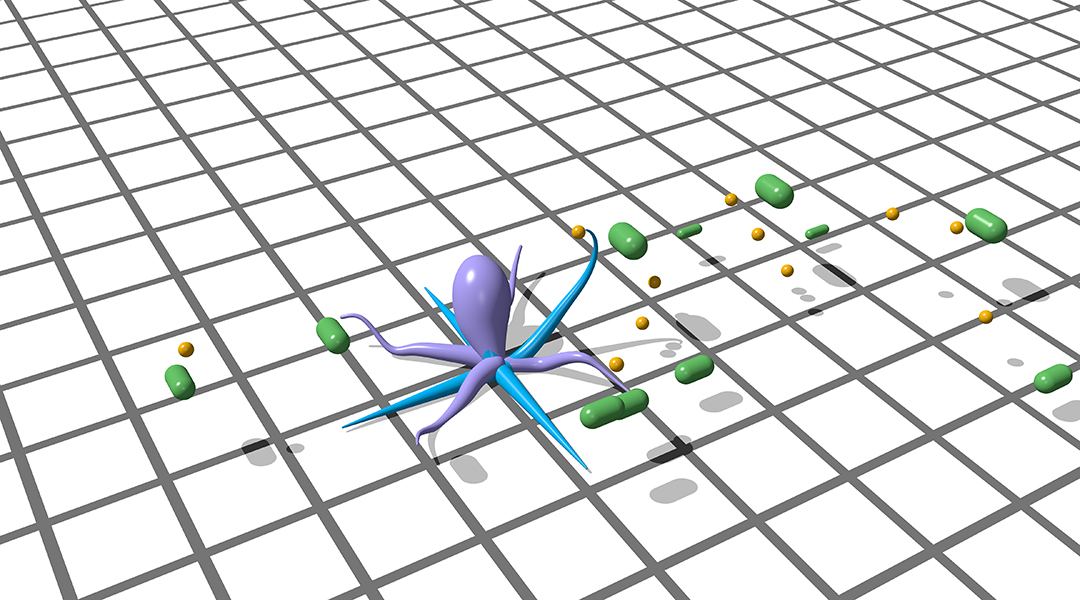Hard, clunky robots often struggle to get around the world as well as animals do. Soft, bendable materials, which better simulate natural muscles, are hailed by roboticists as the key to building more adaptable machines, but because they can move in so many different ways, they are extremely challenging to control.
Evolution already figured out how to control soft materials, so Mattia Gazzola, a mechanical engineering professor at the University of Illinois Urbana-Champaign, turned to nature for inspiration. “All sorts of creatures play tricks to minimize their computing requirements,” he said. “There’s this mechanical intelligence in the body itself.”
No animal embodies the meticulous coordination of soft limbs like the octopus. They’re known for their intelligence and creativity, driven not by one brain, but many.
Octopuses have a highly distributed nervous system, with one brain housed in their mantle (the animal’s blob-like body) performing high-level functions like learning and decision-making, and neural tissue in each limb running more basic motor commands on their own.
The CyberOctopus: A machine learning marvel
Inspired by this hierarchical brain structure — a central controller managing actions powered by the limbs — Gazzola’s team, led by Ph.D. student Chia-Hsien Shih, built an octopus of their own. In a study published in Advanced Intelligent Systems, they present the CyberOctopus, a simulated multi-limbed soft robot that harnesses a hierarchical machine learning strategy to forage for virtual treats.
Each arm of the CyberOctopus was modeled as a bendable rod enveloped by elastic virtual muscles. By activating different combinations of these muscles, the limb can contract, bend, extend, or twist. Traveling waves of muscle contractions can undulate the arms to pull the creature across the floor of a virtual environment, or grab a food target and bring it to its mouth.
One common approach in machine learning and robotics, Gazzola said, is to “throw a huge neural network at the system” and hope it learns what to do. This can work in simple environments where there are a limited number of possible actions and outcomes for the robot to experience. But here, he said, “there are too many variables to deal with. We tried, and it just doesn’t work.”
Instead, Shih and Gazzola designed a three-tiered control system to guide the CyberOctopus. The lowest level deals with obstacles with basically no computation at all, instructing limb muscles to reflexively relax when they bump into something.
Above that, each individual limb employs two simple algorithms that allow it to do two basic behaviors on its own: reach for a food target and crawl. At the top, a more complex algorithm tries to create an optimal sequence of those two behaviors — reach and crawl — to gather as much food as possible while using as little energy as possible.
After confirming that they could activate the muscles required to make the model crawl around a virtual environment, they challenged it with progressively harder food-gathering tasks.
The researchers tracked how much energy the octopus spent relative to how much it regained by eating, and they found that their hierarchical control technique successfully guided the CyberOctopus through its foraging challenges — all without relying on massive neural networks.
“There’s a tendency nowadays to use neural networks for everything,” Gazzola said. “They are very powerful tools. But if you understand the physical problem, then you can leverage that understanding to your advantage.”
Bio-hybrid machines and beyond
While the CyberOctopus succeeded at the tasks it faced here, the model still doesn’t hold a candle to the creative problem-solving abilities of a real octopus. Robots capable of figuring out, on the fly, how to escape from a virtual aquarium “in such a big parameter space, in a complex environment, are not there yet,” Gazzola said.
But materials science, robotics, and machine learning techniques are getting more powerful by the day, so a CyberOctopus imbued with true octopus-like intelligence may be possible down the line.
Moving forward, Gazzola dreams of building bio-hybrid soft machines, which will perform computations using both synthetic and living tissues. “The octopus was an excuse to develop this technology [for broader use],” he said.
For example, soft robots may be especially well-suited for navigating harsh environments where standard rigid robots struggle, like these tube-like inflatable robots that can squeeze through tight spots and lift heavy objects. And softness is always the goal for robots that will interact with humans in potential medical, caretaking, or emergency response roles.
“It’s a vast space,” Gazzola said, with a wide range of future applications to explore. “If you understand the body, you can use it to solve an otherwise difficult problem in a simple fashion. This demonstrates that this is possible.”
Reference: C Shih, et al., Hierarchical Control and Learning of a Foraging CyberOctopus, Advanced Intelligent Systems (2023). DOI: 10.1002/aisy.202300088

















